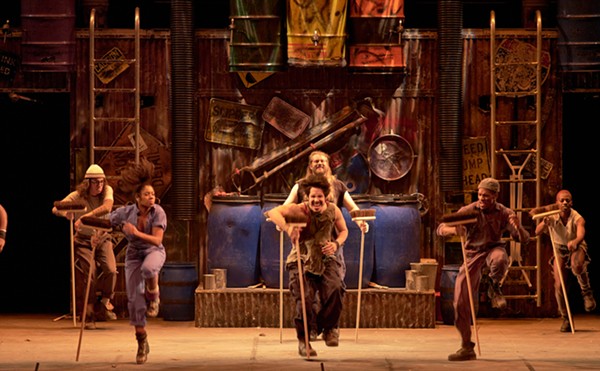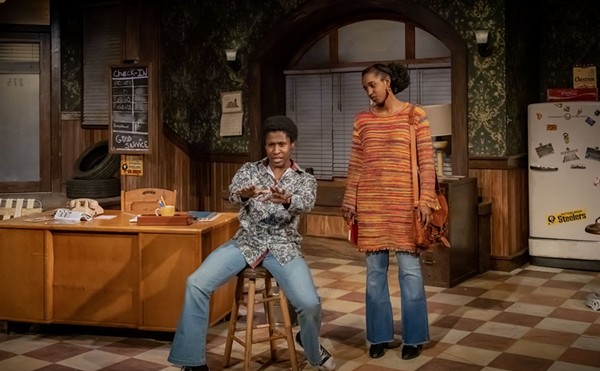Secrets Whispered in the Night -- If these paintings truly represent Maria Winiarski's dreams, she cannot be sleeping well. But their vaguely uneasy atmosphere is also precisely what makes them interesting. This self-taught, resolutely original Lakewood artist here presents a series of exceedingly strange primal images that bear a greater resemblance to hallucinogenic visions than to reality. A cross between a surrealist, a fauvist, and a cave painter, Winiarski bothers little with strict three-dimensional perspective, and her color palette is either brilliantly bright or muted and gritty. She paints with oils on canvas, except, oddly enough, when she's using rubber-backed floorboard. Her greatest concern, it seems, is in creating single-frame mysteries. They can be beautiful, even elegant. Consider the vaporously thin blue fabric draped over a reclining nude in "Sleeping With Her Mask." They can be ugly, like the grotesque "Warrior" with the snake growing out of his head. Some seem like mistakes: Winiarski may not have wanted the free-spirited young girl in "Dancing With Vermeer" to have such a misshapen foot, for instance. The enigma, in almost every case, is how to interpret her works. Winiarski is at her peak when she leaves at least a few clues, as in "Styx," in which a woman contemplates her next step beside the mythological river of Hades. But lack of narrative resolution is OK, if less compelling. A witch with flowing blond hair holding two birds ("Blue Canary") will make a fine conversation piece. Then again, so will almost everything here. Through September 3 at E. Gordon Gallery, 2026 Murray Hill Rd., 216-795-0971, www.egordongallery.com. -- Zachary Lewis
ONGOING
Alicia Basinger: Shiver and Craze -- This recent Cleveland Institute of Art graduate is the latest headliner in MOCA's Emerging Artist Series, and she deserves the spotlight. A ceramist, Basinger makes clay seem like a brand-new medium by mixing it with previously unrelated elements. In "Timber," her most physically impressive work, tall cylinders of wire mesh form the skeletons of tree-like structures with clay skins; each stalk has its own personality, a unique combination of height, width, colors, and blemishes. Standing together in a pod, some of them approaching the ceiling, they take on a sacred, ritualistic aura akin to that of Stonehenge. Basinger also finds success in "Conversion," her deliberate failure to bake a thin layer of clay onto a large slab of steel; the clay peeled away, giving the surface an aged, worn look that's far livelier than the original. Using thicker, two-tone clay for "Passages," she ends up with a raised, heavily cracked surface resembling a patch of desert. One could stare for ages at "Bridge," a pretzel-like knot of blue porcelain loops so complex, they defy comprehension. "Vestiges," meanwhile, consists of a curious series of smaller and usually roundish objects comprising metal, ceramic, and ossified paper. They're survivors, all right: sturdy, nubby remnants of intense heat and profound chemical changes, like meteors that have fallen to earth. Through August 28 at the Museum of Contemporary Art, 8501 Carnegie Ave., 216-421-8671, www.mocacleveland.org. -- Lewis
Michaël Borremans: Hallucination and Reality -- The world envisioned by this young Belgian artist is not an appealing place, even if his skill is in portraying it. In this large exhibition, Borremans outlines, in the most delicate hand, a dark, mechanistic, submissive society in which man and nature are traded and altered like commodities. His pencil drawings, overlaid with light watercolor and other media, such as white ink and tape, recall comic books of the 1940s. At that pre-nuclear time, certainly, his frames of scientists juggling tiny blue and red balls, of powerful men tinkering with fundamental matter, might have been perfect for some pulp novel. Yet it also speaks to current times, when stem-cell research, cloning, and terrorism are hot-button issues. "Slight Modifications," a veritable catalogue of human facial deformities, might be an illustration of the ills scientists now seek to eradicate; alternatively, "Cerebral Office" and "Boxing Heads" -- in which human heads are bought, sold, and stored on racks, as if they were shoes -- argue against genetic tampering. And the giant women towering over a model city, notepads at the ready, in "Terror Watch," demonstrate the ultimate in governmental invasiveness. Incidentally, the piece also exemplifies the strongest tool in Borremans' arsenal: perspective, or exaggerating differences in size. He does this most effectively in "Trickland," a vision of oversized humans crawling over a landscape and rearranging it as if it were a toy train set. Through September 4 at the Cleveland Museum of Art, 11150 East Blvd., 216-421-7340, www.clevelandart.org. -- Lewis
Enamel: Beyond the Object -- Quality varies from piece to piece, but this Spaces show has at least one universal trait: Each work, in its way, successfully defines a new possibility for enamel, the paint that dries with a hard, shiny finish on ceramic. In a show featuring national and international artists, a local name scores the greatest hit: "Party On," by Bay Village artist Kate Ward Terry, features festively colored circles attached to a wall from ceiling to floor, but with heavier concentration at the bottom so they appear to be trickling down on air, like giant falling confetti. More intellectually compelling is Katy Bergman Cassell's "Collapsible Triumph," a four-post archway made of plywood and adorned with a black-and-white Islamic tile pattern. It suggests both permanence and transience; its trappings are flimsy and light, but there is evidence of a great, long-enduring culture. Though similar in some respects, Helen Elliott's "Portable Dwelling" lacks a conceptual foundation. Then again, so do many works in this show. Jessica Calderwood's "Drips" is a rare visual tour de force: Small enamel orbs hang from the ceiling in long nylon sacs; like Terry's work, it derives its power from gravity. Each orb seems to strive for the floor, stretching the fabric the way these artists are stretching enamel's limitations. Through August 5 at Spaces Gallery, 2220 Superior Viaduct, 216-621-2314, www.spacesgallery.org. -- Lewis
Flora and Fauna -- With this one-room show, Michigan-based, Cleveland-trained artist Mary Savage makes a perennially important observation: that human beings are quite as diverse as plants and animals. What's more, she makes her point subtly and creatively. Her medium is enamel -- painting on metal -- an art form with a long history in Cleveland and one that many galleries throughout the city are featuring at present. A series of small, copper-based works lines the walls at eye level. Each includes a picture of a bird, some leaves, and a female figure. Since they're enamels, they're glassy in appearance, almost like watercolor paintings, but more thickly layered. The birds and leaves are all of different species. Similarly, no two of Savage's women are the same; each is a unique combination of skin color, clothing, facial expression, and physical pose. Positioned against the birds and leaves, they call to mind possible images of a well-dressed Eve in the Garden of Eden -- or alternatively, cutouts from old fashion magazines. The room is a quiet shrine, honoring the diversity of all living things. It's a comment always worth making, and Savage makes it with beautiful, artful restraint. Through August 5 at Spaces Gallery, 2220 Superior Viaduct, Cleveland, 216-621-2314, www.spacesgallery.org. -- Lewis
The NEO Show -- Despite its huge variety of media, this juried exhibition of 80 Northeast Ohio artists doesn't offer enough viable alternatives to established tradition. In lieu of deeply considered art are bright colors, appealing surfaces, technical creativity, mechanical gizmos, and ingratiating effects that mostly entertain rather than nourish. Take, for example, Jason Lee's "Greener," a cute installation consisting of backlit photos of grass and a miniature white picket fence; Stephen Litchfield's three-key piano; or Benjamin Kinsley's increasingly annoying video of a young man twisting and shrieking. These were among the best of 1,300 applicants? Thankfully, there are a few saving graces. One never tires of Hildur Jonsson's complex but elegant fiber weavings, and at least one painter -- Brian Sharp -- hasn't abandoned pure abstraction. Photorealist James Seward offers the fine painting "My Father in the Living Room of Our 10th House," a massive close-up of an old man's craggy face, and photography itself is well represented by Herbert Ascherman Jr.'s beautifully obscured black-and-white nightscape and by Michael Loderstedt's sadly effective view of Waccamaw Neck, South Carolina, a historical site currently marred by discarded garbage. Through September 4 at the Cleveland Museum of Art, 11150 East Blvd., 216-421-7350, www.clevelandart.org. -- Lewis
Nina Bovasso -- Stepping inside the new painting installation by New-York-based artist Nina Bovasso at the Museum of Contemporary Art is as exciting as going for a ride on the Tilt-a-Whirl. Her huge design on the rotunda gallery's curved wall looks like paisley gone mad; it surrounds the viewer with an almost dizzying spinning effect. The eye scans the perimeter and flits about the room, frantically seeking visual balances on either side of the circle between a psychedelic array of tall flames, dots, branches, buttons, and swoosh patterns, while the brain seizes almost subconsciously on matching colors across this huge carnivalesque palette. Bovasso fixed her own pictures to the wall like large 21st-century diptychs, then painted new designs that grow around, toward, and away from them like ivy. One near the window is a big, red explosion of paint that seems to spew more design fragments into the atmosphere. No two perspectives are alike in this gallery. Views and responses to those views change according to the focal point and the viewer's position in relation to it. Bovasso spent a week climbing up and down ladders to complete the installation. It's a wonder it didn't take her longer -- and that she didn't fall off. Through August 28 at the Museum of Contemporary Art, 8501 Carnegie Ave., 216-421-8671, www.mocacleveland.org. -- Lewis
Once Familiar -- Claustrophobia may be your first reaction to this exhibition in the museum's sky lounge of works by four local artists. If you use the museum's spiral staircase, you will watch the ceiling get closer and closer, until you enter by poking your head through Carol Hummel's utterly unforgettable installation. Like Spider-Man on drugs, Hummel has spun a thick, multicolored web of yarn over both the gallery's open areas, complete with grandmotherly cozies over parts of the railings. Simultaneously abstract and immediately tangible, Hummel's work here questions the tame identity of yarn as well as its history as a medium. It won't seem quite so familiar after this. (A corresponding video project by Carey McDougall and sculptures by Dylan Collins were not yet in place, as of an early visit.) Just as devilishly creative and playfully subversive as Hummel's installation, though, is a series of faux-antique chairs by Stephen Litchfield, positioned like sentinels around the yarn. Narrow and wobbly, with cracker-sized seats and disproportionately high backs and long legs, Litchfield's humorous constructions are quite useless for sitting -- at least for human sitting. Otherwise, they're made to look exactly like their practical counterparts and would be considered fine furniture in the real world. Through August 14 at the Museum of Contemporary Art, 8501 Carnegie Ave., 216-421-8671, www.mocacleveland.org. -- Lewis
Out There: Landscape in the New Millennium -- Traditional landscape painting may be fading into the sunset, but there's still a bright future for landscape art in general, as this new exhibition of contemporary international works makes clear. Corsican artist Ange Leccia's hypnotic, beautifully disorienting video installation titled "La Mer" features a camera positioned directly above a seashore, filming white-capped waves breaking and retreating on dark sand; displayed onscreen, the wave pattern looks strangely like a slow, undulating geyser. American Jennifer Steinkamp also works magic through video in "Dervish 14," a digitized time-lapse loop of a tree as it winds and unwinds through the seasons. The rest are all photographs: American Tom Bamberger depicts the wide, imposing front edges of dense natural mini-environments, whether thick clumps of "Brown Grass" or a field of high-tech windmills. Ellen Kooi posits people as intrinsic elements of the Dutch countryside in her large, haunting photographs; a row of people emerges directly out of the ocean and onto the land to form a wall in "The Dike," while in another picture, a man frozen in a seemingly impossible backflip forms a bridge over a creek. Rosemary Laing, in four images from a series called "One Dozen Unnatural Disasters in the Australian Landscape," draws intriguing comparisons between fire as a destructive force and the harsh climate of her land. Through August 28 at the Museum of Contemporary Art, 8501 Carnegie Ave., 216-421-8671, www.mocacleveland.org. -- Lewis
Sculpture Garden -- The small sculpture garden at Atmosphere's new Tremont digs is filled with engaging sights. Alex Stoll's burnt-steel dragonflies and squirrels hover over shrubbery like busy real-life creatures. A large insect with brightly colored metal bars for legs oversees the garden's back half. Near the front, Lothar Jobczyk's "Garden Spirits" -- sandstone blocks with craggy, totemic faces -- poke their heads above the plants; commendably, Jobczyk managed to give each one a personality without squandering their dense, stony qualities. But the sculptures by Frank Brozman and Jerry Schmidt are the kings of this jungle. Brozman's are abstract realizations in brown steel of familiar materials and physical processes. Ornate flower planters are among his more obvious examples, but he can be subtler: At first, his "Insatiable" looks like nothing more than a large flat piece of steel connected to its stand by a metal coil. Viewed from the side, however, it becomes a face and stomach forever trapped in a cycle of feeding and regurgitating. Schmidt's "Photogenic" compares in size to the giant insect, but surpasses it conceptually: A circle of blue steel punctures a large, flesh-colored plate, like a lens coming out of a camera. Not only does it evoke photography in this way; the whole, curvaceous, semi-animate thing appears to be posing for a picture. Through the summer at Atmosphere Gallery, 2379 Professor Ave., Suite 1, 216-685-9527. -- Lewis












